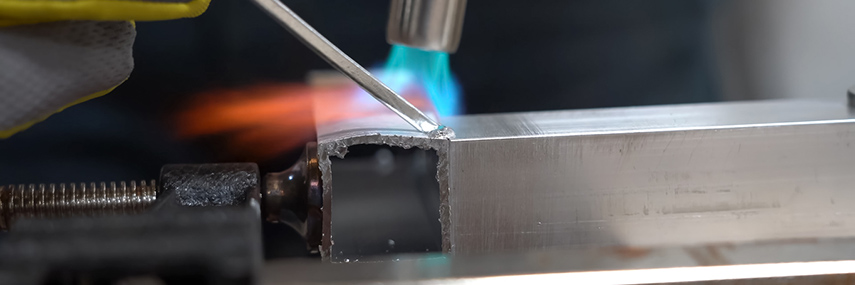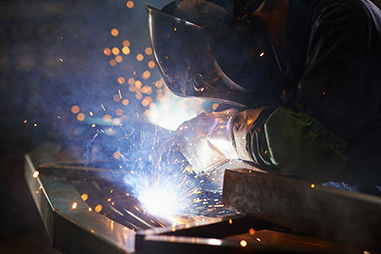Read Our Blog
A Complete Beginner’s Guide to Aluminum Welding

Welding aluminum often presents more challenges than steel, which is why people often ask, can you weld aluminum? It requires different techniques, knowledge, and special skills you can acquire with practice. Here’s a complete guide to aluminum welding to help you understand the essential aspects.
5 Top Benefits of Aluminum
The use of aluminum as a structural element is relatively recent. From the year 1886, it became available in commercial quantities. Since then, welders have used it in many applications, including trucks, automobiles, aircraft, marine equipment, cookware and more. It offers several advantages as follows:
- Lightweight: Aluminum has an excellent strength-to-weight ratio and becomes stronger with decreasing temperature. It is a great choice if you require strength yet need the material to remain lightweight.
- Electricity and Heat: Aluminum conducts heat and electricity almost as good as copper.
- Non-Corrosive: Although oxidation is a challenge that welders encounter during welding, aluminum is non-corrosive.
- Recyclable: This metal is cost-efficient and recyclable, making it increasingly popular.
- Appearance: It absorbs sealant and paint, making the result aesthetically pleasing.
Essential Things to Consider When Welding Aluminum
Choosing the proper welding process is crucial when working with aluminum. Moreover, it requires unique tools and equipment. In addition, here are a few critical things to keep in mind during the aluminum welding procedure:
- Clean the material thoroughly using a mild alkaline solution or a solvent like acetone to remove impurities. Remove grease, oil, and water vapour from the surface and prep it adequately to achieve the desired result.
- Use a stainless steel wire brush and acid to remove surface oxides.
- If you do not want to weld the cleaned part immediately, assemble the joint and cover it adequately to prevent grit or dirt from contaminating the material.
- Rinse and dry the metal and keep it at room temperature before welding.
Safety Measures When Welding Aluminum
Safety is a critical component of aluminum welding. Keep in mind the following to prevent mishaps during the process:
- Be sure to use proper protective equipment such as safety glasses, goggles, gloves, the right shoes, and a welding helmet to protect yourself from sparks and splatters.
- Ensure adequate fume ventilation to avoid health hazards.
5 Common Types of Aluminum Welding
TIG Welding
Tungsten inert gas (TIG) welding or gas tungsten arc welding (GTAW) is a popular aluminum welding process. It is typically used in the automotive industry, particularly for professional racing teams. It uses argon as a shielding gas and requires constant current equipment with AC capabilities. TIG aluminum welding does not need mechanical wire feeding. The welder feeds the filler material into a puddle. It is a clean procedure because the alternating current removes the aluminum’s oxidized layer, preventing contamination.
Tips for GTAW or TIG Welding
- Choose the right tungsten rod or electrode.
- Prepare the aluminum by preheating and cleaning it.
- Do not allow too much argon flow at the torch to prevent irregular arcs.
- Use a heat sink to prevent warping.
- Keep the filler electrode free of contaminants during the welding process and melt it with the base material to create a constant puddle.
MIG Welding
Metal inert Gas (MIG) welding or gas metal arc welding (GMAW) is a common method for welding aluminum. It has higher deposition rates and faster travel speeds than TIG welding. However, it uses a mechanical wire feeding system, indicating that the welder may use a push-pull or spool gun to ensure wire feeding. To prevent aluminum from becoming porous, clean the filler rod and the base material, ensure they are moisture-free and have excellent shielding gas coverage.
Tips for MIG Aluminum Welding
- Prepare the push-pull wire feed.
- Clean the aluminum thoroughly, remove the oxide and file the edges that need joining.
- Push at a 10° – 15° angle and avoid pulling when welding.
- Use multiple pass straight beads to prevent defects and enhance the appearance of the weld.
- Use a heat sink to weld slower and absorb extra heat.
Laser Beam Welding
Also known as electron beam welding, it requires an easily controlled and precise heat-affected zone, making it ideal for aluminum. It offers fast and clean welds and is appropriate for aluminum, which is prone to cracking.
Resistant Welding
This method joins metals by applying pressure and allowing a current to pass through the metal. It is wise to be cautious when using this welding technique because of aluminum’s high electrical and thermal conductivity.
Shielded Metal Arc Welding (SMAW)
This welding method is typically used to repair cast aluminum. It uses constant current equipment with an aluminum rod with electrode-positive polarity.
5 Things to Avoid During Aluminum Welding
Taking a Common Approach
When welding aluminum, you must take a unique direction than one with a material like steel. Do not base your technique on your working experience with other metals, and handle the material carefully and correctly.
Not Wearing Proper Protective Equipment
Welding any material is inherently dangerous, so it is crucial to wear the correct PPE and educate yourself on the best practices and appropriate safety procedures.
Failing to Prepare
Clean the aluminum and store it correctly before beginning the weld. Do not be negligent. Prepare yourself by learning the theoretical aspects of aluminum welding.
Ignoring Minute Details
When welding aluminum, the slightest misstep can lead to complicated problems. Paying attention to every detail and checking your work to achieve the expected output is beneficial.
Being Impatient
It is vital to be patient during the aluminum welding process. This will ensure precision and help avoid errors.
Leverage Our Nexalloy Advantage for Aluminum Welding
Nexal Aluminum Inc. offers a range of products known for precision welding and ease of use. Our premium-quality aluminum welding consumables are engineered to meet the demands of several applications, including robotic welding, marine, fabrication, automotive, and trailer manufacturing.
If you are looking for aluminum welding consumables near you in North America, call us at 1-905-629-8282 or fill out our online form. Our expert welders will be glad to help you.






